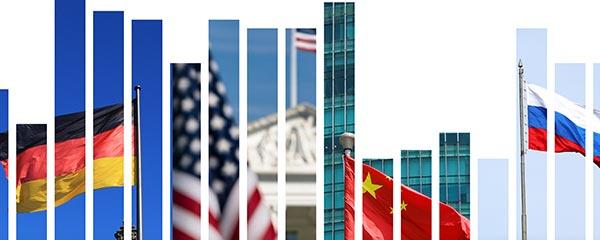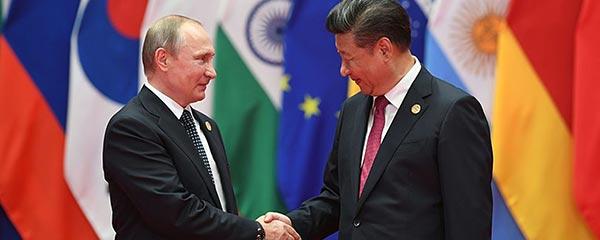This article is the third in a series detailing the results from the latest Rating World Leaders report, which analyzes trends in approval ratings of the leadership of the U.S., Germany, Russia and China in over 130 countries.
WASHINGTON, D.C. -- The U.S. is currently beating China in the competition for leadership approval in much of the world. But, as a new Gallup report shows, this approval can depend a great deal on who is in power.
Based on relative net approval scores, the U.S. enjoyed an advantage in 81 out of 133 countries that Gallup surveyed in 2023, while China had an advantage in 52.
The United States' net approval advantage was largest in Kosovo at +154 points (+78 U.S. net approval and -76 Chinese net approval). China’s advantage was largest in Russia at -132 points (-82 U.S. net approval and +50 Chinese net approval).
In any country, net approval of the U.S. minus net approval of China results in a relative net approval score between 200 and -200. A score of 200 means everyone approves of U.S. leadership and disapproves of Chinese leadership, while a score of -200 indicates the opposite. A score of 0 suggests parity, where the U.S. and China share the same net approval score.
(For more on this calculation, see the Leadership Net Approval and Soft Power section after the first chart.)
Leadership Net Approval and Soft Power
Countries advance their interests in various ways. They use soft power -- exerting their influence through culture, values and diplomacy -- to get what they want without resorting to economic or military coercion.
Soft power is a multifaceted concept that is difficult to measure. It broadly occurs at two levels: the elite level (politicians) and the population level (general public), with interplay between these two. Elites can shape popular beliefs about other countries. In turn, popular beliefs about other countries can shape the strategic environment in which elites operate.
For almost 20 years, Gallup has asked people worldwide if they approve or disapprove of the leadership of the U.S., China, Russia and Germany. Gallup calculates leadership net approval -- the difference between the percentage who approve and the percentage who disapprove of a country’s leadership -- to capture the general sentiment a population has about the job performance of a global leader.
The resulting net approval score offers a useful proxy for an important component of soft power at the population level.
Gallup takes the difference between the net approval scores of two country leaders -- the U.S. and China, for example -- to produce a relative net approval score that captures the competitive and strategic nature of geopolitics. At times, foreign policy objectives of powerful countries like the U.S. and China are at odds. Holding other factors constant, the great power that has a net approval advantage in a country of interest may have a better chance to realize its objectives.
The Balance Has Shifted Over Time
While the U.S. enjoyed a meaningful net approval advantage over China in 2023, there have been notable short- and long-term shifts over the past two decades in which Gallup has been tracking global attitudes. These shifts notably coincide with changes in U.S. presidential administrations, from George W. Bush and Barack Obama to Donald Trump and Joe Biden.
The accompanying figure illustrates shifts in net approval advantages over time. Each dot represents a country.
- The solid diagonal line is the inflection point. Countries above the line indicate an advantage for China, and below it, an advantage for the U.S.
- The dashed diagonal lines designate a 50+-point advantage for China (dots above the upper dashed line) or for the U.S. (dots below the lower dashed line).
- The quadrants capture country types:
- Quadrant 1 -- positive net approval for China and negative net approval for the U.S.
- Quadrant 2 -- positive net approval for China and the U.S.
- Quadrant 3 -- negative net approval for China and the U.S.
- Quadrant 4 -- negative net approval for China and positive net approval for the U.S.
- The counters in the chart show how many countries fall into these various categories each year.

Scatterplot that rotates between multiple years. Global leadership advantage -- U.S. versus China, from 2007 to 2023, by country (in 133 or 134 countries). The number of countries in which the U.S. has a clear advantage is lower in 2007 and 2008 but becomes much higher from 2009 to 2016, and then drops again from 2017 to 2020, rising again into the 90s in 2021 and 2022 and the 80s in 2023. The number of countries in which China has a clear advantage starts out in the 60 range, dropping into the 30s and 40s from 2009 to 2016, rising into the 80s and 90s from 2017 to 2019, followed by a drop into the 50s in 2020, 20 in 2021, and the 40s and 50s in 2022 and 2023.
Whiplash?
Based on these data, the U.S. appears to enjoy a significant net approval advantage under Democratic leadership and a significant disadvantage under Republican leadership. The magnitude of these swings comes into stark focus when one compares country alignments across years.
Two other patterns are visible. First, the bounce-back under the Biden administration to Obama-era levels suggests the U.S. net approval advantage is resilient, especially when one focuses on the proportion of strongly aligned and aligned countries.
Second, the proportion of countries “strongly aligned” or “aligned” with China has remained generally anemic. China’s peak advantage existed in 2007, when it was emerging on the global stage. While China made significant short-term country gains during the Trump presidency, most of these fell into the “weakly aligned” category. Greater familiarity has not increased attraction to Chinese leadership.
A Great Disillusionment?
Analysis of the proportion of countries in each quadrant reveals a general trend toward fewer countries falling into quadrant 2 (positive net approval for China and the U.S.) and more falling into quadrant 3 (negative net approval for China and the U.S.).
The proportion of countries in quadrant 3 was highest under the Trump administration, peaking in 2020 at 48%. While the proportion of countries in quadrant 3 under the Biden administration has shrunk from that all-time high, it remains roughly double the level seen during most of the Obama administration.
This trend toward an increasing number of countries expressing negative net approval of U.S. and Chinese leadership suggests a growing lack of enthusiasm for these two global powers.
Long-Term Realignment in Asia and Sub-Saharan Africa
Although short-term shifts in leadership net approval of the U.S. and China are revealing, long-term shifts offer a means to measure strategic realignments of specific countries. The following analysis accounts for swings associated with changes in U.S. administrations by taking the average relative net approval score over four consecutive years, where two years are under a Democratic president and the other two years under a Republican president.
A change of 30 to 50 points between 2007-2010 and 2019-2022 is considered a slight realignment, and a change of 50+ points a strong realignment. The most country realignments occurred in Asia and sub-Saharan Africa.
In sub-Saharan Africa, China has made long-term gains in Tanzania, Uganda, South Africa and Malawi. The general parity in the countries’ net approval of the U.S. and China between 2019 and 2022 is challenging to interpret. This realignment may indicate steady movement toward an ever-growing Chinese net approval advantage. Alternatively, the 2007-2010 era may be the high-water mark for the U.S. in these countries, given Obama’s election and the general popularity of Bush-era initiatives.
In Asia, the U.S. has made long-term gains in India, the Philippines, South Korea and Vietnam, which suggest the heart is not fonder with proximity. China’s muscular activities in its neighborhood appear to have elicited a threat response that pushes these countries toward the U.S. orbit.
Bottom Line
A country’s soft power emanates from perceptions of who it is, what it does, how it does it, and what it says. As part of that, significantly more countries seem to prefer U.S. leadership over Chinese leadership, at least under Democratic administrations.
In recent years, the U.S. net approval advantage over China appears to have rebounded after periods of disadvantage under the two previous Republican administrations. What remains uncertain is how much this rebound effect will persist if the U.S. continues to swing between what much of the world seems to see as two distinct Americas. Because China’s ability to enhance global perceptions of its leadership appears limited, the U.S. advantage seems to be its to lose, regardless of who wins the 2024 presidential election.
To stay up to date with the latest Gallup News insights and updates, follow us on X.
For complete methodology and specific survey dates, please review Gallup's Country Data Set details.
Learn more about how the Gallup World Poll works.




